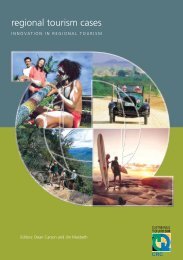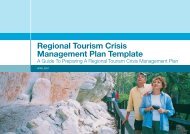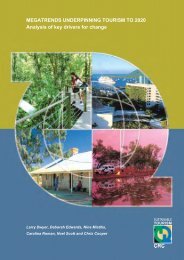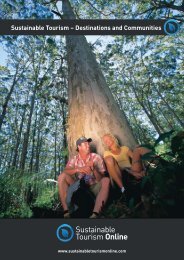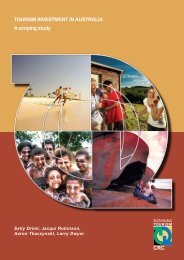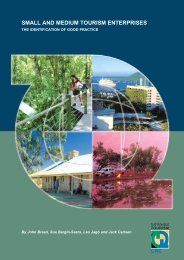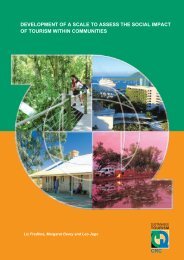Tourism Risk Management - Sustainable Tourism Online
Tourism Risk Management - Sustainable Tourism Online
Tourism Risk Management - Sustainable Tourism Online
You also want an ePaper? Increase the reach of your titles
YUMPU automatically turns print PDFs into web optimized ePapers that Google loves.
• Get involved in defining security procedures<br />
<strong>Tourism</strong> authorities need to be aware of all security measures being taken that affect their industry.<br />
Review the entire tourism chain - airport arrivals, ground transport, hotels, restaurants, shopping<br />
zones and all tourism sites. Consider the need for enhanced security at all sites, including beaches or<br />
entertainment districts. The goal is to provide a safe environment with procedures that are as<br />
invisible as possible and do not restrict the arrival of visitors.<br />
• Maintain information on visitor safety and security<br />
<strong>Tourism</strong> industry bodies at the national, state/provincial and local levels should liaise with other<br />
government bodies, specialized services and the tourism sector on safety and security issues. They<br />
should also keep records on basic facts of tourism security such as rules and regulations,<br />
identification of risks, safety statistics and incidents. In addition, information should be shared with<br />
counterpart organizations around the world.<br />
• Train local personnel in security issues<br />
Government and industry tourism organizations can take an active role in improving safety and<br />
security by sponsoring workshops on safety issues for local tourism workers and by encouraging<br />
partnerships between public and private security companies in the tourism sector, including local<br />
police and hotel security guards. In addition, they should undertake community awareness programs<br />
that help local residents recognize the value of tourism to their communities. They can help make it<br />
safer for visitors by reporting suspicious activities.<br />
• Establish tourism police and emergency call centres<br />
Special tourism police forces, such as ones in Argentina, Australia, the Dominican Republic, Egypt,<br />
Greece and Malaysia, are trained to offer assistance in several languages. Mexico’s Green Angels<br />
patrol the highways with bilingual crews (see Case Study in Chapter 3). Other countries offer call<br />
centres with multilingual operators to handle emergencies involving visitors. Information on how to<br />
contact these emergency services needs to be communicated clearly to visitors on arrival.<br />
D) Research readiness<br />
• Facilitate information exchange systems with key tourism operators<br />
Set up arrangements with local hotels, airlines and tour operators for the provision of up-to-theminute<br />
data on overnight stays, occupancy rates, pricing, etc. Establish an email or fax system<br />
capable of receiving this data from these key partners.<br />
• Monitor hospital admissions involving visitors<br />
Information on non-crisis situation hospital admissions of visitors can be used as a point of<br />
comparison to put any possible problems in the future in perspective.<br />
• Monitor crimes against visitors<br />
Statistics on crimes against visitors can help experts find gaps in security services, improve the<br />
quality of the destination and help avoid crisis-scale problems in the future. Crime statistics can also<br />
be used as background information, providing a context for crisis communication and a reference<br />
point for demonstrating a return to normalcy.<br />
II. Minimizing Damage<br />
The first 24 hours of a crisis are crucial. An ineffective and unprofessional response can exacerbate<br />
the situation for the destination, but responsible management of the crisis can enhance relations with<br />
the travel trade and facilitate the destination’s recovery process.<br />
A) Communications from the front line<br />
76 <strong>Tourism</strong> <strong>Risk</strong> <strong>Management</strong> – An Authoritative Guide to Managing Crises in <strong>Tourism</strong>



